Free Vibration Analysis of Foam-Core Sandwich Structures
Foam-core, free vibration, natural frequencies, numeric analysis, sandwich structures
Free Vibration Analysis of Foam-Core Sandwich Structures
___
- [1] Burlayenko, V. N. and Sadowski, T. “Influence Of Skin/Core Debonding On Free Vibration Behavior Of Foam And Honeycomb Cored Sandwich Plates” Internatıonal Journal Of Non-Lınear Mechanıcs 45 (10): 959–968, 2010.
- [2] Goh, C. S., Gupta, M. J., Wei, L. and Lee, C. “Characterization Of High Performance Mg/MgO Nanocomposites.” Journal of Composite Materials 41(19): 2325–2335,2007.
- [3] Petrone, G., Alessandro, V. D., Franco, F. Mace, B. and De Rosa, S. “Modal Characterisation Of Recyclable Foam Sandwich Panels.” Composite Structures 113(1): 362–368, 2014.
- [4] Apalak, Z. G., Ekici, R., Yildirim, M., Apalak, M. K. “Free Vibration Analysis Of An Adhesively Bonded Functionally Graded Double Containment Cantilever Joint.” Journal of Adhesion Science and Technology 28(12): 1117–1139, 2014.
- [5] Chen, J. E., Zhang, W., Sun, M., Yao, M. H., Liu, J. “Free Vibration Analysis Of Composite Sandwich Plates With Different Truss Cores.” Mechanics of Advanced Materials and Structures, 24(1): 1–13, 2017.
- [6] Sakar, G., and Bolat, C. “The Free Vibration Analysis of Honeycomb Sandwich Beam Using 3D and Continuum Model” International Journal of Mechanical and Mechatronics Engineering 9 (6): 1077-1081, 2015.
- [7] Lashin, M. M. A, and Nady, A. O. E. “The Free Vibration Analysis of Sandwich Beam Stracture Using Finite Element Approach” Journal of Mechanical and Civil Engineering 12 (1): 34-42, 2015.
- [8] Khare, R. K., Kant, T., and Garg, A. A. “Free Vibration of Composite and Sandwich Laminates With a Higher-Order Facet Shell Element.” Composite Structures 65: 405–418, 2004.
- [9] Nilsson, E., and Nilsson, A. C. “Prediction and Measurement of Some Dynamic Properties of Sandwich Structures with Honeycomb and Foam Cores.” Journal of Sound and Vibration, 251: 409-430, 2002.
- [10] Li, Z., and Crocker, M. J. “Effects of Thickness and Delamination on the Damping in Honeycomb–Foam Sandwich Beams.” Journal of Sound and Vibration 294: 473-485, 2006.
- [11] Lai, L. “Study of Free Vibration of Aluminum Honeycomb Panels.” MSc. Thesis, Toronto University, 2002.
- ISSN: 1302-0900
- Yayın Aralığı: 6
- Başlangıç: 1998
- Yayıncı: GAZİ ÜNİVERSİTESİ
Mikroşebeke İçin Mas Tabanlı Dağıtılmış Akıllı Kontrol ve Hata Kontrol Stratejisinin Geliştirilmesi
A New Approach to Minimize Memory Requirements of Frequent Subgraph Mining Algorithms
TURGAY TUGAY BİLGİN, Turgay Tugay BİLGİN
Üç Sıkıştırılabilir Malzemeden Yapılmış Ön Gerilmeli Bir Plakanın Frekans Tepkisi
Turgay Tugay BİLGİN, Murat OĞUZ
Zeynep BATUR, Halil İ. AKYILDIZ
Microstructural and Mechanical Properties of Ti3SiC2-CNF Composite Materials by PM
Abdualkarim Musbah M. GARİBA, Faik OKAY, Ibtesam Said Shneeb SAİD, Serkan ISLAK
